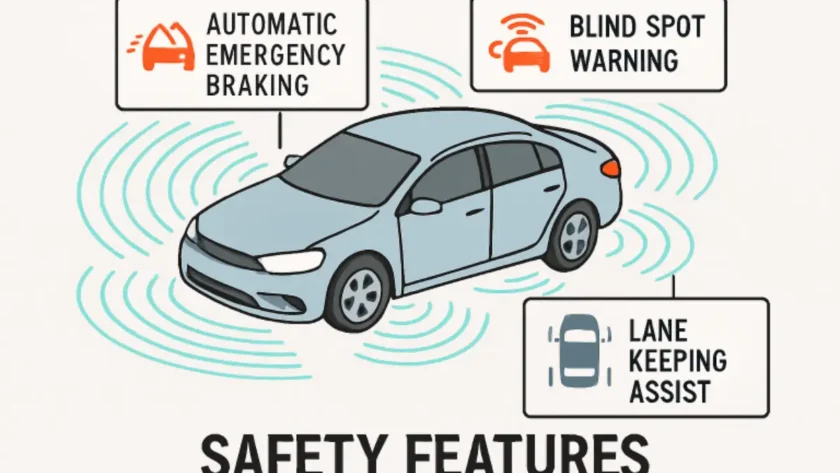The automotive industry is profoundly transforming, as car manufacturers respond to consumer demand and increasing government regulations by prioritizing vehicle safety. Advanced safety features are quickly becoming essential components of new cars, changing the landscape of road travel for everyone.
These innovations are engineered to protect those inside vehicles, pedestrians, cyclists, and other motorists sharing the road. This means every drive is safer and smarter, matching technology with responsibility.
Navigating today’s busy roads can be challenging for many drivers, especially with rising traffic volumes and distractions. Advanced safety systems offer peace of mind by giving drivers another set of “eyes” on the road and sometimes even the ability to step in when human reactions fall short.
Whether you are a seasoned driver with years of experience behind the wheel or someone shopping for their very first car, understanding the capabilities and value of these safety features is crucial.
Modern safety technologies are now so influential that they often play a deciding role in choosing which vehicle to purchase. Learn more about vehicles currently leading the pack to discover which of the latest models are equipped with these state-of-the-art safety technologies.
Contents
Automatic Emergency Braking (AEB)
Automatic Emergency Braking (AEB) is a revolutionary development in collision prevention. This advanced system uses forward-facing sensors, cameras, and radar to continuously scan the road ahead for vehicles, pedestrians, or other obstacles.
Suppose the system detects an imminent collision and the driver does not react quickly enough. In that case, AEB automatically applies the brakes to slow or even stop the car, potentially preventing an accident or reducing its severity.
According to industry experts and studies, AEB systems have reduced rear-end collisions by up to 50% in some cases. This lowers the chances of injury and saves drivers and insurance companies substantial amounts on costly vehicle repairs.
Drivers of vehicles equipped with AEB report feeling much more confident, especially during urban commutes and when a momentary lapse in attention can have serious consequences. AEB operates seamlessly, offering peace of mind and making roads safer for everyone, including other motorists and pedestrians.
Blind Spot Warning (BSW)
Merging and changing lanes are common but potentially dangerous actions that drivers face daily. The traditional side and rearview mirrors leave blind spots that can hide approaching vehicles, making lane changes risky.
Blind Spot Warning (BSW) systems solve this problem by continuously monitoring areas alongside and just behind the car. When another vehicle is detected in a driver’s blind zone, BSW provides a visual or audible alert, sometimes vibrating the steering wheel or seat.
The added awareness created by BSW significantly reduces the likelihood of side-swipe accidents and unsafe merges. Research from the Insurance Institute for Highway Safety indicates that cars with BSW experience a 14% reduction in all lane-change crashes and a 23% reduction in crashes causing injuries. This substantial risk reduction makes BSW one of the most valued features in contemporary automotive safety. For more on how this technology impacts safety.
Lane Departure Warning (LDW) and Lane Keeping Assist (LKA)
Distracted driving and drowsiness are significant challenges on highways and rural roads. Lane Departure Warning (LDW) and Lane Keeping Assist (LKA) are designed to counteract these risks by ensuring drivers stay safely within their designated lanes. LDW uses cameras to monitor lane markings, alerting drivers with warning sounds or steering wheel vibrations if they begin to drift unintentionally.
Lane Keeping Assist takes safety one step further by actively guiding the vehicle back toward the center of the lane if it senses an unintentional drift and no corrective action by the driver. These features prove invaluable during long stretches of highway driving or when traveling at night, helping drivers who may become fatigued or momentarily distracted. By reducing the chances of dangerous lane departures, LDW and LKA provide a vital safety net, helping prevent collisions that might otherwise occur in the blink of an eye.
Adaptive Cruise Control (ACC)
Adaptive Cruise Control (ACC) enhances traditional cruise control by utilizing radar and sensors to maintain a safe distance from the car ahead. Instead of keeping the car at a set speed, ACC adjusts speed automatically in response to the traffic situation, slowing down or accelerating to ensure the following distance is always safe.
This means a far more relaxing and stress-free experience for drivers, especially on long road trips or during stop-and-go traffic. The constant adjustments made by ACC help reduce fatigue, improve traffic flow, and decrease the risk of rear-end collisions.
As vehicles evolve toward higher levels of automation, systems like ACC are becoming a cornerstone of semi-autonomous vehicle technology. Their impact on overall road safety is now widely recognized, as highlighted by the National Highway Traffic Safety Administration.
Impact on Insurance Premiums
Investing in a car that offers advanced safety features provides added security and can yield real financial benefits. Many insurance companies recognize that vehicles with technologies like AEB, BSW, LDW, and ACC face a lower risk of accidents and costly claims. As a result, drivers of such vehicles may be eligible for substantial discounts on their insurance premiums, making these features attractive from both a safety and economic standpoint.
Over time, the reduced collisions and the decreased severity of injuries among vehicles equipped with advanced safety technologies influence insurance companies to pass on some savings to their customers. In addition, as market demand continually shifts toward safer vehicles, cars with these modern systems often retain higher resale values. For drivers focused on both immediate safety and long-term value, incorporating these features into their next car purchase makes tremendous sense.
As new cars increasingly come packed with advanced safety features, how we think about driving is rapidly changing. From short commutes to cross-country trips, these systems—ranging from AEB and BSW to LDW, LKA, and ACC—work together to guard against everyday risks on the road.
The comprehensive suite of available protective technologies boosts confidence, reduces accidents, and delivers invaluable peace of mind for drivers, passengers, and everyone else they encounter.
With safety technologies becoming standard rather than optional, automakers are setting new benchmarks and giving consumers solid reasons to demand the latest advancements in every new purchase. Advanced safety features represent a wise and forward-thinking investment for those looking to future-proof their next vehicle while also enjoying direct benefits like lower insurance costs and better resale value.
As this technology continues to evolve, the positive effect on communities, families, and individuals will only become more pronounced, leading to safer journeys and stronger, more resilient road networks for years to come.




